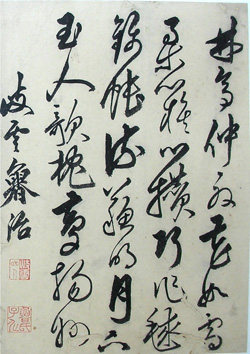| Detailed stylistic analysis of Chinese painting typically focuses on brushwork, with examination of speed, weight, duration of inkflow and consequent 'colour' of greys in ink application, as well as particularities in the rendering of representation. Concern for brushwork is also central in examining signatures on paintings, and more broadly, calligraphy. Stylistic analysis also is concerned with space, illusions of volume, and overall compositional dynamics. This attends to a wider effect than brushwork per se, and is often more visible when the observer looks at the work from a slight distance. It is also common to look for 'continuity' or 'flow' in the overall execution. This is contrasted to 'stiffness' and 'hesitation'. This is particularly useful in distinguishing copies or close imitations. In side-by-side comparisons, a copy often fails to match an original precisely because the artist is overly focused on appearance and looses touch with the deeper structure of the work. As a result, a landscape will seem 'a bit flat' with an insufficient illusion of volume in un-painted areas. Or a piece of calligraphy will not have the underlying driving force running through the linkages of characters that provides authority to the original. This approach to style also echoes the creative work of literati artists. Even when imitation of masterworks was practiced, it was essential that the artist gave an authentic artwork a distinctive unity and a coherent flow, and so necessarily departed from slavish copying. | | 
 |